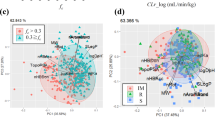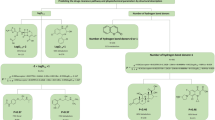Abstract
Purpose
The clearance pathways of drugs are critical elements for understanding the pharmacokinetics of drugs. We previously developed in silico systems to predict the five clearance pathway using a rectangular method and a support vector machine (SVM). In this study, we improved our classification system by increasing the number of clearance pathways available for our prediction (CYP1A2, CYP2C8, CYP2C19, and UDP-glucuronosyl transferases (UGTs)) and by accepting multiple major pathways.
Methods
Using the four default descriptors (charge, molecular weight, logD at pH 7.0, and unbound fraction in plasma), three kinds of SVM-based predictors based on traditional single-step approach or two-step focusing approaches with subset or partition clustering were developed. The two-step approach with subset clustering resulted in the highest prediction performance. The feature-selection of additional descriptors based on a greedy algorithm was employed to further improve the predictability.
Results
The prediction accuracy for each pathway was increased to more than 0.83 with the exception of CYP2C19 and UGTs pathways, whose accuracies were below 0.7. Prediction performance of CYP1A2, CYP3A4 and renal excretion pathways were found to be acceptable using external dataset.
Conclusions
We successfully constructed a novel SVM-based predictor for the multiple major clearance pathways based on chemical structures.


Similar content being viewed by others
Abbreviations
- CYP:
-
Cytochrome P450
- fup :
-
Protein unbound fraction in plasma
- logD:
-
Octanol-water distribution coefficient
- MW:
-
Molecular weight
- OATP:
-
Organic anion transporting polypeptide
- SVM:
-
Support vector machine
- UGT:
-
UDP-glucuronosyltransferase
- VDW:
-
Van der Waals
References
Lavecchia A, Di Giovanni C. Lavecchia A. Virtual screening strategies in drug discovery: a critical review. Curr Med Chem. 2013;20(23):2839–60.
Zhu T, Cao S, Su PC, Patel R, Shah D, Chokshi HB, et al. Hit identification and optimization in virtual screening: practical recommendations based on a critical literature analys. J Med Chem. 2013;56(17):6560–72.
Kusama M, Toshimoto K, Maeda K, Hirai Y, Imai S, Chiba K, et al. In silico classification of major clearance pathways of drugs with their physiochemical parameters. Drug Metab Dispos. 2010;38:1362–70.
Toshimoto K, Wakayama N, Kusama M, Maeda K, Sugiyama Y, Akiyama Y. In silico prediction of major drug clearance pathways by support vector machines with feature-selected descriptors. Drug Metab Dispos. 2014;42:1811–9.
US Food and Drug Administration (FDA). Guidance for Industry. In Vitro Metabolism- and Transporter- Mediated Drug-Drug Interaction Studies; 2017 October. Available from: https://www.fda.gov/downloads/Drugs/GuidanceComplianceRegulatoryInformation/Guidances/UCM581965.pdf.
European Medicines Agency (EMA). Guideline on the Investigation of Drug interactions; 2012 June. Available from: http://www.ema.europa.eu/docs/en_GB/document_library/Scientific_guideline/2012/07/WC500129606.pdf.
Kudo T, Hisaka A, Sugiyama Y, Ito K. Analysis of the repaglinide concentration increase produced by gemfibrozil and itraconazole based on the inhibition of the hepatic uptake transporter and metabolic enzymes. Drug Metab Dispos. 2013;41(2):362–71.
Hinton LK, Galetin A, Houston JB. Multiple inhibition mechanisms and prediction of drug-drug interactions: status of metabolism and transporter models as exemplified by gemfibrozil-drug interactions. Pharm Res. 2008;25(5):1063–74.
Gan J, Chen W, Shen H, Gao L, Hong Y, Tian Y, et al. Repaglinide-gemfibrozil drug interaction: inhibition of repaglinide glucuronidation as a potential additional contributing mechanism. Br J Clin Pharmacol. 2010;70(6):870–80.
Williams JA, Hyland R, Jones BC, Smith DA, Hurst S, Goosen TC, et al. Drug-drug interactions for UDP-glucuronosyltransferase substrates: a pharmacokinetic explanation for typically observed low exposure (AUCi/AUC) ratios. Drug Metab Dispos. 2004;32(11):1201–8.
Sakiyama Y, Yuki H, Moriya T, Hattori K, Suzuki M, Shimada K, et al. Predicting human liver microsomal stability with machine learning techniques. J Mol Graph Model. 2008;26:907–15.
Yamashita F, Hara H, Ito T, Hashida M. Novel hierarchical classification and visualization method for multiobjective optimization of drug properties: application to structure-activity relationship analysis of cytochrome P450 metabolism. J Chem Inf Model. 2008;48:364–9.
Alexandrov V, van Albada G, Sloot P, Dongarra J. Computational Science - ICCS 2006, 1st Ed. Springer-Verlag Berlin Heidelberg, UK; 2006.
Varma MV, Feng B, Obach RS, Troutman MD, Chupka J, Miller HR, et al. Physicochemical determinants of human renal clearance. J Med Chem. 2009;52:4844–52.
Ewing TJ, Makino S, Skillman AG, Kuntz ID. DOCK 4.0: search strategies for automated molecular docking of flexible molecule databases. J Comput Aided Mol Des. 2001;15:411–28.
Freitas RF, Bauab RL, Montanari CA. Novel application of 2D and 3D-similarity searches to identify substrates among cytochrome P450 2C9, 2D6, and 3A4. J Chem Inf Model. 2010;50(1):97–109.
Shimada T, Yamazaki H, Mimura M, Inui Y, Guengerich FP. Interindividual variations in human liver cytochrome P-450 enzymes involved in the oxidation of drugs, carcinogens and toxic chemicals: studies with liver microsomes of 30 Japanese and 30 Caucasians. J Pharmacol Exp Ther. 1994;270:414–23.
Yu LX, Amidon GL, Polli JE, Zhao H, Mehta MU, Conner DP, et al. Biopharmaceutics classification system: the scientific basis for biowaiver extensions. Pharm Res. 2002;19:921–5.
Wu CY, Benet LZ. Predicting drug disposition via application of BCS: transport/absorption/elimination interplay and development of a biopharmaceutics drug disposition classification system. Pharm Res. 2005;22:11–23.
Varma MV, Steyn SJ, Allerton C, El-Kattan AF. Predicting clearance mechanism in drug discovery: extended clearance classification system (ECCS). Pharm Res. 2015;32:3785–802.
Author information
Authors and Affiliations
Corresponding author
Rights and permissions
About this article
Cite this article
Wakayama, N., Toshimoto, K., Maeda, K. et al. In Silico Prediction of Major Clearance Pathways of Drugs among 9 Routes with Two-Step Support Vector Machines. Pharm Res 35, 197 (2018). https://doi.org/10.1007/s11095-018-2479-1
Received:
Accepted:
Published:
DOI: https://doi.org/10.1007/s11095-018-2479-1




